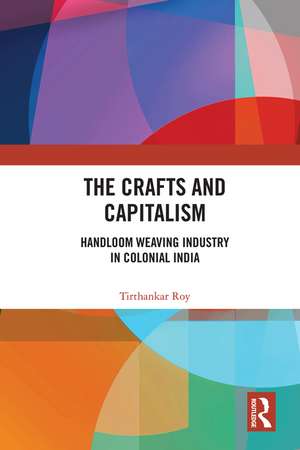The Crafts and Capitalism: Handloom Weaving Industry in Colonial India
Autor Tirthankar Royen Limba Engleză Hardback – 12 feb 2020
An important intervention in Indian economic history, this book will be useful to scholars and researchers of Indian history, economic history, colonial history, modern history, political history, labour history and political economy. It will also interest nongovernmental organizations, textile historians, and design specialists.
| Toate formatele și edițiile | Preț | Express |
|---|---|---|
| Paperback (1) | 382.54 lei 6-8 săpt. | |
| Taylor & Francis – 30 sep 2021 | 382.54 lei 6-8 săpt. | |
| Hardback (1) | 764.20 lei 6-8 săpt. | |
| Taylor & Francis – 12 feb 2020 | 764.20 lei 6-8 săpt. |
Preț: 764.20 lei
Preț vechi: 1027.40 lei
-26% Nou
Puncte Express: 1146
Preț estimativ în valută:
146.24€ • 152.87$ • 123.58£
146.24€ • 152.87$ • 123.58£
Carte tipărită la comandă
Livrare economică 07-21 martie
Preluare comenzi: 021 569.72.76
Specificații
ISBN-13: 9780367365288
ISBN-10: 0367365286
Pagini: 200
Ilustrații: 28
Dimensiuni: 156 x 234 x 18 mm
Greutate: 0.45 kg
Ediția:1
Editura: Taylor & Francis
Colecția Routledge India
Locul publicării:Oxford, United Kingdom
ISBN-10: 0367365286
Pagini: 200
Ilustrații: 28
Dimensiuni: 156 x 234 x 18 mm
Greutate: 0.45 kg
Ediția:1
Editura: Taylor & Francis
Colecția Routledge India
Locul publicării:Oxford, United Kingdom
Public țintă
PostgraduateCuprins
List of Figures, Maps, Tables. Preface 1. Introduction 2. Scale and Composition, 1795-1940 3. Consumption and Market 4. Capital and Labour 5. Tools and Techniques 6. Towns and Regions 7. Handlooms and Powerlooms, 1920-1990 8. Handloom after Independence. Glossary. Selected Biographies. References. Index
Notă biografică
Tirthankar Roy is Professor of Economic History, London School of Economics and Political Science, UK where he teaches South Asia and Global History. He is the author of India in the World Economy: From Antiquity to the Present (2012); Law and the Economy in Colonial India (with Anand V. Swamy, 2016); and The Economy of South Asia from 1950 to the Present (2017). His research interests are history and development of South Asia, global history, empires, and environmental history.
Recenzii
‘The literature on decline and survival of the handloom sector in India in the nineteenth century had been ideological, focusing on the British policies of deliberate destruction of the industry. This book, based on data and quantitative estimation rather than preconceived assertions, is a much-needed contribution to the literature. A leading contributor to Indian economic history, Roy more than anybody else is well positioned to write this narrative.’
Bishnupriya Gupta, Professor of Economics, University of Warwick, UK
‘Given the continued importance of artisanship generally and handloom weaving particularly, both in cultural and economic terms, the book would be likely to find a wide audience among development workers, those interested in cultural heritage, as well as anyone interested in economic history more broadly.’
Abigail McGowan, Associate Professor of History & Associate Dean of the College of Arts and Sciences, University of Vermont, USA
Bishnupriya Gupta, Professor of Economics, University of Warwick, UK
‘Given the continued importance of artisanship generally and handloom weaving particularly, both in cultural and economic terms, the book would be likely to find a wide audience among development workers, those interested in cultural heritage, as well as anyone interested in economic history more broadly.’
Abigail McGowan, Associate Professor of History & Associate Dean of the College of Arts and Sciences, University of Vermont, USA
Descriere
This book presents a comprehensive history of handloom weaving industry in India. It shows that skill-intensive handmade textiles survived the competition on a large scale, and that handmade goods and high-quality manual labour played a positive role in the making of modern India.
